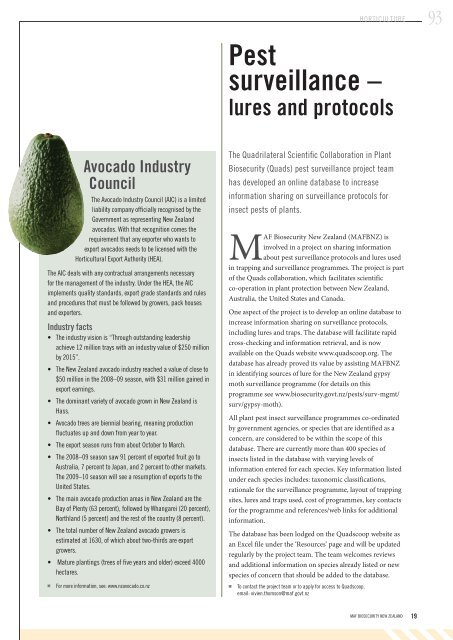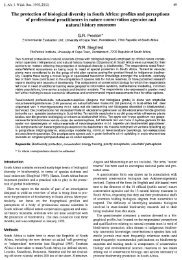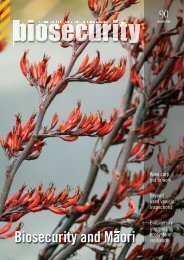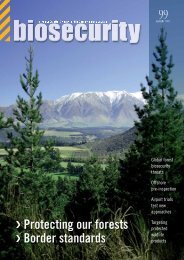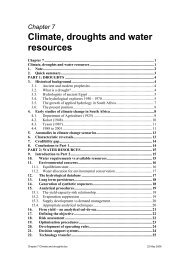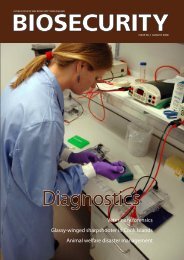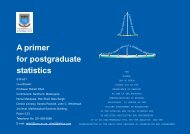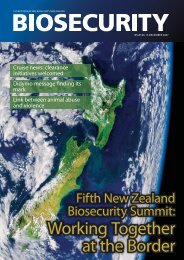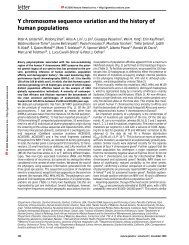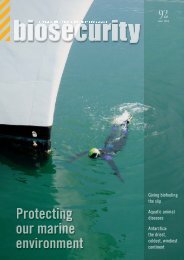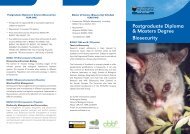AVOCADOS - Biosecurity New Zealand
AVOCADOS - Biosecurity New Zealand
AVOCADOS - Biosecurity New Zealand
You also want an ePaper? Increase the reach of your titles
YUMPU automatically turns print PDFs into web optimized ePapers that Google loves.
HORTICULTURE93Pestsurveillance –lures and protocolsAvocado IndustryCouncilThe Avocado Industry Council (AIC) is a limitedliability company officially recognised by theGovernment as representing <strong>New</strong> <strong>Zealand</strong>avocados. With that recognition comes therequirement that any exporter who wants toexport avocados needs to be licensed with theHorticultural Export Authority (HEA).The AIC deals with any contractual arrangements necessaryfor the management of the industry. Under the HEA, the AICimplements quality standards, export grade standards and rulesand procedures that must be followed by growers, pack housesand exporters.Industry facts• The industry vision is “Through outstanding leadershipachieve 12 million trays with an industry value of $250 millionby 2015”.• The <strong>New</strong> <strong>Zealand</strong> avocado industry reached a value of close to$50 million in the 2008–09 season, with $31 million gained inexport earnings.• The dominant variety of avocado grown in <strong>New</strong> <strong>Zealand</strong> isHass.• Avocado trees are biennial bearing, meaning productionfluctuates up and down from year to year.• The export season runs from about October to March.• The 2008–09 season saw 91 percent of exported fruit go toAustralia, 7 percent to Japan, and 2 percent to other markets.The 2009–10 season will see a resumption of exports to theUnited States.• The main avocado production areas in <strong>New</strong> <strong>Zealand</strong> are theBay of Plenty (63 percent), followed by Whangarei (20 percent),Northland (5 percent) and the rest of the country (8 percent).• The total number of <strong>New</strong> <strong>Zealand</strong> avocado growers isestimated at 1630, of which about two-thirds are exportgrowers.• Mature plantings (trees of five years and older) exceed 4000hectares.■For more information, see: www.nzavocado.co.nzThe Quadrilateral Scientifi c Collaboration in Plant<strong>Biosecurity</strong> (Quads) pest surveillance project teamhas developed an online database to increaseinformation sharing on surveillance protocols forinsect pests of plants.MAF <strong>Biosecurity</strong> <strong>New</strong> <strong>Zealand</strong> (MAFBNZ) isinvolved in a project on sharing informationabout pest surveillance protocols and lures usedin trapping and surveillance programmes. The project is partof the Quads collaboration, which facilitates scientificco-operation in plant protection between <strong>New</strong> <strong>Zealand</strong>,Australia, the United States and Canada.One aspect of the project is to develop an online database toincrease information sharing on surveillance protocols,including lures and traps. The database will facilitate rapidcross-checking and information retrieval, and is nowavailable on the Quads website www.quadscoop.org. Thedatabase has already proved its value by assisting MAFBNZin identifying sources of lure for the <strong>New</strong> <strong>Zealand</strong> gypsymoth surveillance programme (for details on thisprogramme see www.biosecurity.govt.nz/pests/surv-mgmt/surv/gypsy-moth).All plant pest insect surveillance programmes co-ordinatedby government agencies, or species that are identified as aconcern, are considered to be within the scope of thisdatabase. There are currently more than 400 species ofinsects listed in the database with varying levels ofinformation entered for each species. Key information listedunder each species includes: taxonomic classifications,rationale for the surveillance programme, layout of trappingsites, lures and traps used, cost of programmes, key contactsfor the programme and references/web links for additionalinformation.The database has been lodged on the Quadscoop website asan Excel file under the ‘Resources’ page and will be updatedregularly by the project team. The team welcomes reviewsand additional information on species already listed or newspecies of concern that should be added to the database.■To contact the project team or to apply for access to Quadscoop,email: vivien.thomson@maf.govt.nzMAF BIOSECURITY NEW ZEALAND 19


